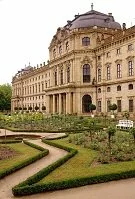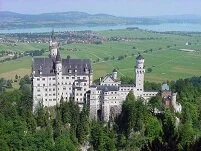
Wurzburg Residence
Baroque architecture is a style with vast difference from one part of Europe to the next, but similar features are generally found within any single country. Germany is the exception to this since the style was generally divided by Catholic and Protestant beliefs and feelings towards church architecture. As the home to the Reformation, Germany saw a divide on this architectural front with Bavaria and other Catholic areas being more expressive in the style than the northern and primarily Protestant part of the country. Unfortunately, due to the Thirty Years' War, few true Baroque buildings were built, as latter Baroque, known as Rococo, became more significant. The best example of the early Baroque style in Germany is perhaps the Wurzburg Residence (1700s).
The examples of Rococo architecture are numerous and abound in Germany. The Augustusburg and Falkenlust Palaces (early 1700s) in Bruhl were some of the first buildings in this style in Germany. The Church of Wies (1745-1754) made the style more authentically German, more specifically Bavarian, as did Ottobeuren Abbey when it was rebuilt in the early 1700s. The New Palace (1763-1769) in Potsdam is the best example of northern German, specifically Prussian, Baroque or Rococo architecture.
After Baroque and Rococo in Germany, there were numerous styles that flourished, most notably neo-Classicism, although numerous sub-sets of this style also exist. The most notable and famous neo-classical monument is Brandenburg Gate (1789-1793) in Berlin. Humboldt University and Museumsinsel in Berlin also have a number of buildings in this style. The city of Weimar built a lot of architecture during this time, many of which are neo-Classically influenced as well.

Neuschwanstein Castle
The New Town Hall in Munich (1867 and 1908) is an example of Gothic Revival, while Neuschwanstein Castle (1869-1886) near Fussen is an example of Romanesque Revival or Romanticism, two more styles common in Germany in the late 1700s-early 1900s.
Modern architecture entered Germany in the early 1900s and to this day is one of the most popular and populous styles, particularly in the cities. One of the earliest examples of this style is the Fagus Factory in Alfeld (1910). This building represents the new building styles, techniques, and materials from the Industrial Revolution while contributing to that revolution as a factory. During this same time (1910-1933) the Berlin Modernism Housing Estate was built. Additionally, since WWII destroyed many of the buildings in the major cities, cities like Berlin, Frankfurt, Dresden, Cologne, and Munich have an incredible number of modern buildings throughout.